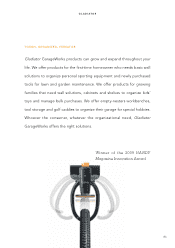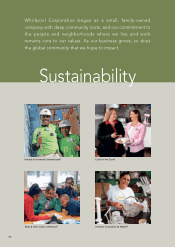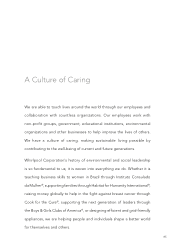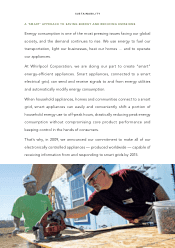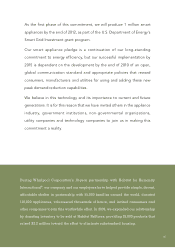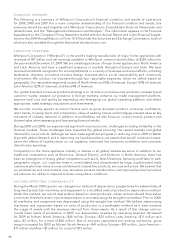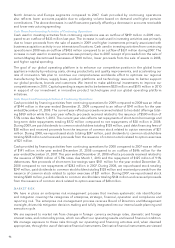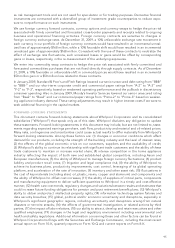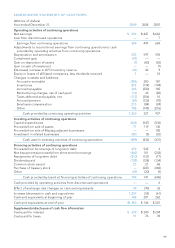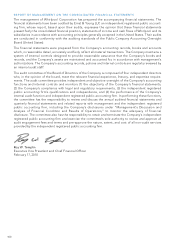Whirlpool 2009 Annual Report Download - page 94
Download and view the complete annual report
Please find page 94 of the 2009 Whirlpool annual report below. You can navigate through the pages in the report by either clicking on the pages listed below, or by using the keyword search tool below to find specific information within the annual report.
Gross Margin
The consolidated gross margin percentage increased compared to 2008 due primarily to cost reduction
initiatives and productivity improvements, partially offset by foreign currency and lower regional tax incen-
tives associated with BEFIEX.
The table below summarizes gross margin percentages by region:
2009 Change 2008 Change 2007
North America 12.9% 2.9 pts 10.0% (2.5) pts 12.5%
Europe 11.5 (2.5) 14.0 (2.6) 16.6
Latin America 17.2 (4.0) 21.2 0.4 20.8
Asia 19.3 1.1 18.2 3.0 15.2
Consolidated 14.0 0.7 13.3 (1.6) 14.9
Significant regional trends were as follows:
• North America gross margin increased in 2009 compared to 2008 primarily due to continued cost reduc-
tions and improved productivity, product price/mix and a post retirement curtailment gain associated
with the suspension of annual credits to retiree health savings accounts totaling $80 million. Additionally,
gross margin was positively impacted by a $41 million reduction in LIFO reserves resulting from cost
deflation. These gross margin improvements were partially offset by the unfavorable impacts of lower
volumes, foreign currency and $35 million in charges associated with a product recall. Gross margin
decreased in 2008 compared to 2007 primarily due to higher material and oil-related costs, lower indus-
try demand and lower productivity. Additionally, gross margin was positively impacted by certain asset
sale gains totaling $31 million and postretirement curtailments totaling $15 million, which were more
than offset by $42 million in higher reserves for LIFO resulting from cost inflation and a $32 million
charge related to product recall. These decreases were partially offset by improved product price/mix.
• Europe gross margin decreased in 2009 compared to 2008 due primarily to lower volumes, unfavorable
foreign currency fluctuations, asset sale gains and insurance proceeds totaling $14 million recognized in
2008. These decreases were partially offset by cost reductions and productivity initiatives and lower
material and oil-related costs. Gross margin decreased in 2008 compared to 2007 due primarily to lower
productivity and industry demand, which were partially offset by improved product price/mix. Also
contributing to lower gross margin were gains from asset sales of $9 million compared with $47 million
recognized in 2007. Lower gains in 2008 associated with asset sales were partially offset by gains of
$5 million from insurance proceeds.
• Latin America gross margin decreased in 2009 compared to 2008 due primarily to a reduction in regional
tax incentives associated with BEFIEX, higher material and oil-related costs, lower price/mix and
an operating tax settlement, offset by improved productivity and certain credits in the amount of
$11 million related to refundable energy surcharges. Gross margin increased in 2008 compared to 2007
due primarily to improvements in product price/mix, productivity and regional tax incentives associated
primarily with BEFIEX, which combined to more than offset higher material and oil-related costs.
• Asia gross margin increased in 2009 compared to 2008 primarily due to continued cost reductions and
improved productivity and a $3 million asset sale gain, which were partially offset by lower product
price/mix. Gross margin increased in 2008 as compared to 2007 due to improvements in product price/
mix, productivity, inventory transition costs and volume, which more than offset higher material and oil-
related costs.
Selling, General and Administrative
In 2009, consolidated selling, general and administrative expenses, as a percent of consolidated net sales,
decreased compared to the prior year, primarily as a result of infrastructure cost reductions and lower
brand investments. In 2008, consolidated selling, general and administrative expenses, as a percent of
consolidated net sales, increased compared to 2007, primarily due to lower sales volume and higher brand
investment, partially offset by lower infrastructure costs and $20 million in gains associated with asset
sales. Additionally, this increase was impacted by a $12 million operating tax credit recorded by our Latin
America region during 2007.
90





